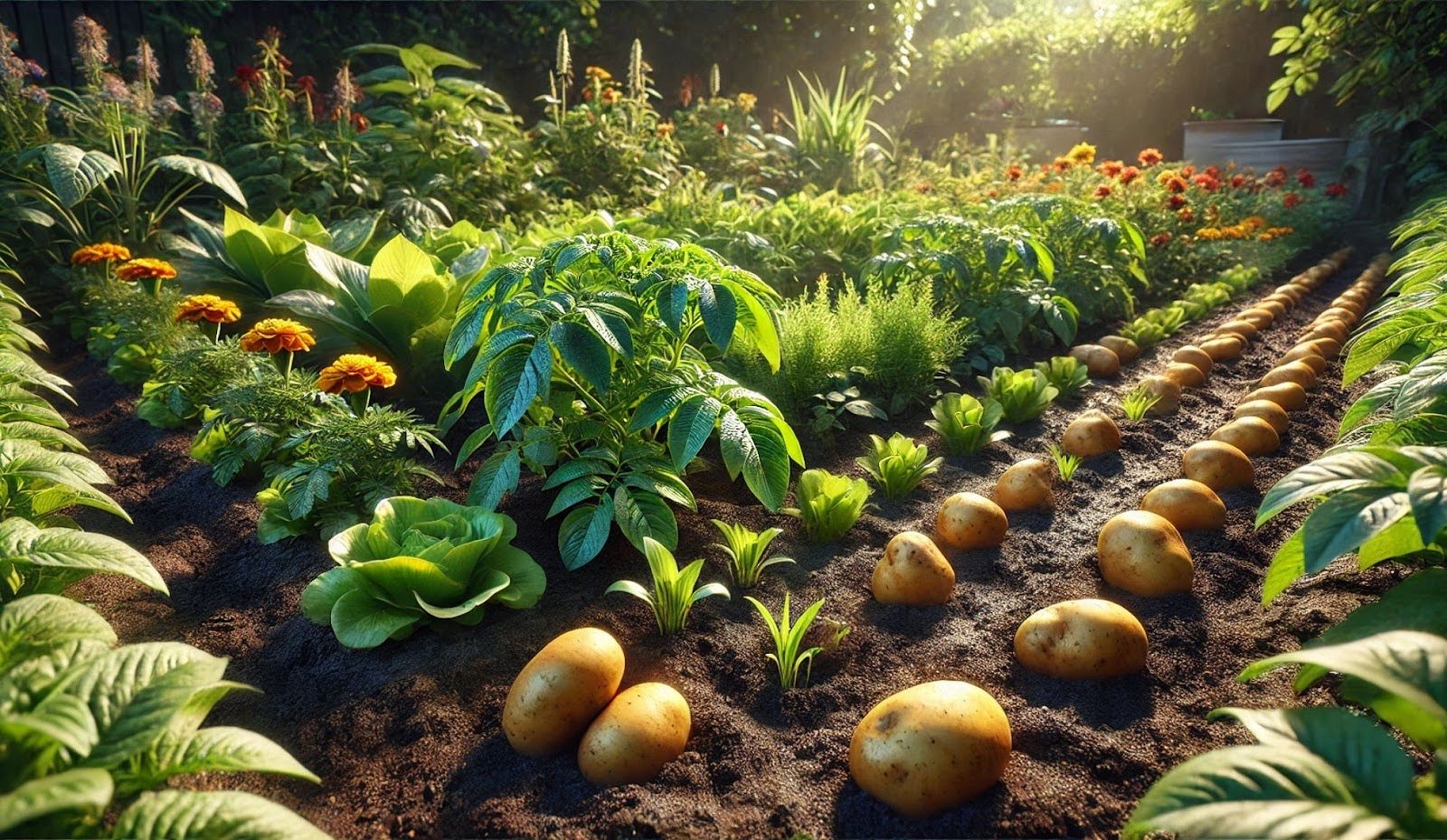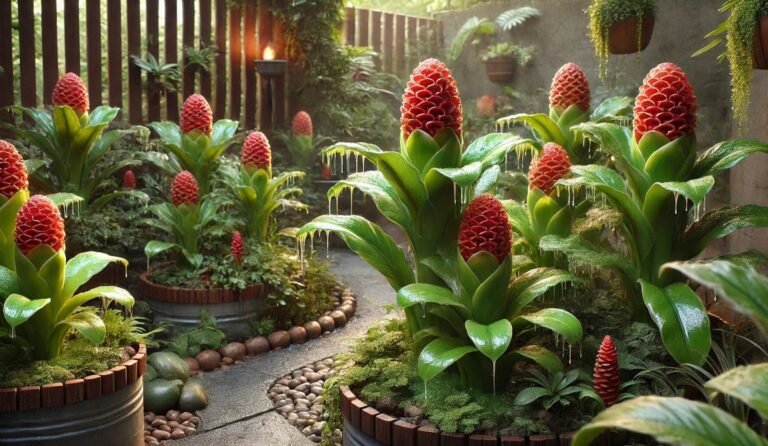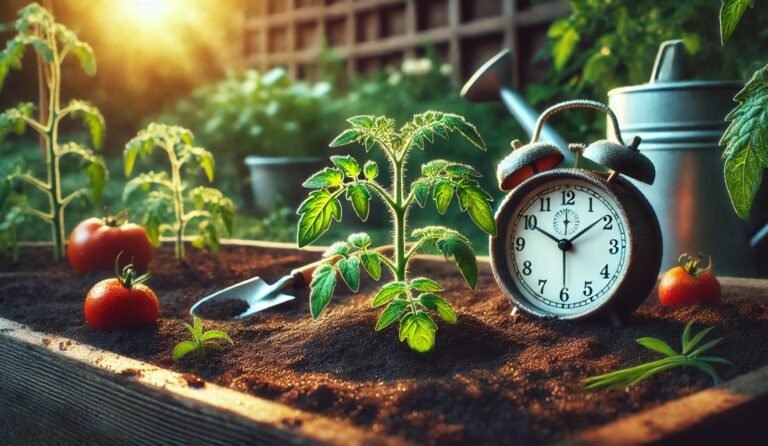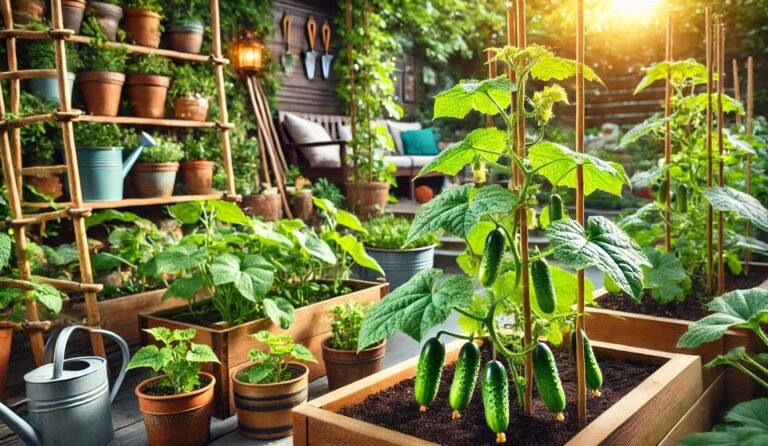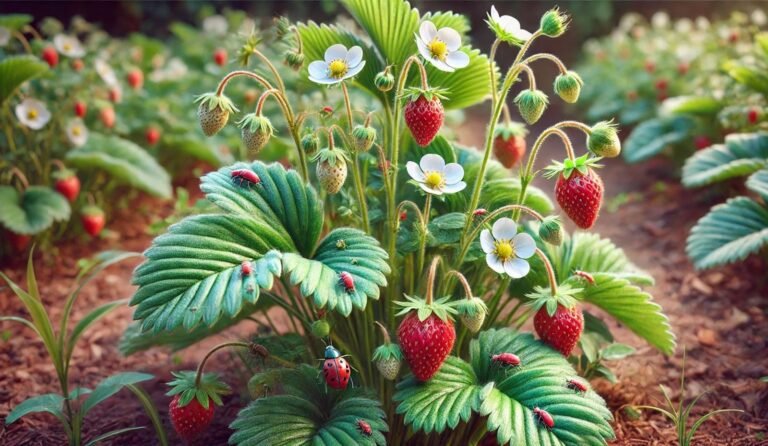What Can You Plant with Potatoes? The Best Companion Plants & What to Avoid
What can you plant with potatoes? The right companions can boost your harvest, keep pests away, and even improve soil health. But pick the wrong ones, and you’ll end up with stunted growth or disease-prone spuds. Want to know which plants play nice with potatoes—and which ones don’t? This guide breaks it all down, from pest-fighting flowers to nitrogen-fixing greens. Let’s dig in and set your potatoes up for success!
What is Companion Planting?
Companion planting is a time-tested gardening method that enriches and protects vulnerable crops. Farmers and gardeners plant specific crops near each other in order to deter pests, attract beneficial insects, and stimulate growth.
What Are the Benefits of Companion Planting?
What can you plant with potatoes? First, we have to understand the benefits of Companion Planting. Companion plants will either help a specific crop grow or will grow better beside a specific crop, and can do many support jobs in the garden:
1. Repel insect pests. Cabbage worms, cucumber beetles, flea beetles, Mexican bean beetles, carrot flies, cabbage moths—all kinds of pests can plague vegetable gardens. Many companion plants (like marigold flowers, catnip, and rue) repel specific pests and should be planted near certain crops as natural pest control. Other companion plants (like calendula and nasturtiums) attract certain pests and can be planted a short distance away from your garden to lure those pests away from your vegetables.
2. Attract beneficial insects. Pollinators like honey bees and ladybugs can use a little encouragement to visit vegetable gardens and pollinate the crops. Gardeners often plant attractive plants like borage flowers to encourage pollinators to visit.
3. Improve soil nutrients. When crops grow, they take up valuable nutrients from the soil—leaving the gardener to do a lot of work at the end of the season to renew the soil’s nutrients. However, there are many companion plants (like bush beans and pole beans) that add nutrients like nitrogen back into the soil, helping keep other plants healthy.
4. Encourage faster growth and better taste. Many companion plants (like marjoram, chamomile, and summer savory) release specific chemicals that encourage faster growth or better taste in the plants around them.
5. Provide ground cover. Plants that spread low across the ground (like oregano) serve as a blanket over the soil, protecting it from the sun and keeping it cooler for plants that benefit from lower temperatures.
6. Provide necessary shade. Plants that grow tall and leafy (like zucchini and asparagus) can provide welcome shade for sun-sensitive plants beneath them.
Why Companion Planting Works for Potatoes
Companion planting isn’t just an old gardening myth—it’s a science-backed technique that enhances plant growth and protection. Potatoes are heavy feeders, meaning they absorb a lot of nutrients from the soil. They’re also prone to pests like Colorado potato beetles, aphids, and blight, which can quickly destroy an entire crop.
By choosing the right plants to grow alongside potatoes, you can:
Deter pests naturally (reducing the need for chemical pesticides)
Improve soil fertility by adding nitrogen or breaking up compacted soil
Save space in your garden by pairing plants that don’t compete for nutrients
Enhance potato flavor and yield
Now, let’s dive into the best plants you can grow with potatoes for a healthier, more productive garden.
The Best Companion Plants for Potatoes
1. Lettuce & Spinach: The Perfect Ground Cover
If you want to make the most of your garden space, planting lettuce or spinach alongside potatoes is a smart choice. These leafy greens have shallow roots, meaning they won’t compete for nutrients with the deep-rooted potatoes. Instead, they help retain soil moisture, provide shade to keep the ground cool, and suppress weeds. Another advantage? Lettuce and spinach grow fast, so they can be harvested before potato plants get too large, making them an excellent early-season companion.
2. Turnips: A Pest-Repelling Powerhouse
Turnips may not be the first plant that comes to mind when thinking about companion plants for potatoes, but they’re a fantastic choice. They act as a trap crop, attracting pests like flea beetles away from your potato plants. Instead of feasting on your potato leaves, these pests will target the turnips—saving your main crop from damage. Additionally, turnips loosen the soil as they grow, making it easier for potatoes to develop without struggling against compacted dirt.
3. Beans & Peas: The Nitrogen Boosters
Potatoes love nitrogen-rich soil, and beans and peas are natural nitrogen fixers. These legumes pull nitrogen from the air and store it in the soil, improving fertility and reducing the need for artificial fertilizers. Planting pole beans near your potato rows can also provide some shade and help regulate soil moisture, keeping conditions optimal for potato growth.
4. Garlic & Onions: Natural Pest Deterrents
If you want to keep pests away from your potatoes, planting garlic and onions nearby is a game-changer. These strong-smelling plants repel aphids, spider mites, and even the dreaded Colorado potato beetle. Onions also take up very little space and don’t compete heavily with potatoes for nutrients. Plus, they’re a great addition to your kitchen—so it’s a win-win!
5. Herbs (Basil, Thyme, and Catnip): Nature’s Pest Control
Certain herbs work wonders in protecting potatoes from insects. Thyme and basil are known for repelling potato beetles, while catnip can deter aphids and other harmful bugs. Planting aromatic herbs among your potato plants doesn’t just provide natural pest control—it also makes your garden smell amazing!
6. Marigolds & Nasturtiums: The Secret Weapons Against Pests
Flowers like marigolds and nasturtiums are some of the best plants you can grow alongside potatoes. Not only do they attract pollinators, but they also serve as a powerful pest deterrent.
Marigolds release a chemical into the soil that repels root-knot nematodes, which can harm potato plants.
Nasturtiums attract aphids away from your potatoes, acting as a trap crop.
These flowers don’t just protect your potatoes—they also add a burst of color to your garden!
Companion Plants for Sweet Potatoes

While sweet potatoes belong to the same family as regular potatoes, they have different growing habits. Sweet potatoes thrive in warm, loose soil and spread out as they grow, so the best companion plants for sweet potatoes are those that don’t interfere with their vines.
Here are some of the best plants to grow with sweet potatoes:
Root vegetables like carrots & beets – These help aerate the soil without competing with sweet potatoes for space.
Beans & peas – Like with regular potatoes, legumes improve soil quality and boost growth.
Dill, thyme, and oregano – These herbs help deter pests that might attack sweet potato vines.
Avoid planting potatoes and sweet potatoes together, as they attract similar pests and diseases.
What Not to Plant Next to Potatoes
Not all plants make good neighbors for potatoes. Certain crops should be avoided because they either compete for the same nutrients, attract pests, or increase the risk of disease.
Plants to Avoid:
- Tomatoes, Peppers, and Eggplants – These belong to the same nightshade family as potatoes and are prone to late blight, which can wipe out your crop.
- Cucumbers and Pumpkins – These compete for nutrients and can attract similar pests.
- Carrots and Parsnips – While they may seem harmless, they attract root-knot nematodes, which can harm potatoes.
- Sunflowers and Corn – These tall plants attract pests like wireworms, which attack potato roots.
What Can You Plant with Potatoes? (Crop Rotation Tips)
Growing potatoes in the same spot year after year depletes the soil and increases the risk of disease. To keep your garden healthy, practice crop rotation by planting different crops after your potato harvest.
Best Crops to Plant After Potatoes:
Legumes (Beans, Peas, Clover) – Restore nitrogen to the soil.
Brassicas (Cabbage, Broccoli, Cauliflower) – Utilize different nutrients than potatoes.
Leafy greens (Lettuce, Spinach, Kale) – Grow well in the soil left behind by potatoes.
Avoid planting tomatoes or peppers in the same spot immediately after potatoes to prevent disease spread.
How to Protect Potato Plants Naturally
Even with good companion planting, it’s essential to take additional steps to protect your potato plants from pests and diseases.
- Mulching – Adding straw or dried leaves around potatoes retains moisture and prevents weeds.
- Handpicking Pests – If you spot Colorado potato beetles, remove them by hand to prevent an infestation.
- Proper Spacing – Overcrowding leads to poor air circulation, which increases disease risks.
- Rotating Crops – Avoid planting potatoes in the same spot each year.
FAQ
What grows well with potatoes?
Lettuce, spinach, beans, peas, garlic, onions, herbs (basil, thyme, catnip), marigolds, nasturtiums, and turnips make great companion plants for potatoes.
What should not be planted next to potatoes?
Avoid planting tomatoes, peppers, eggplants, cucumbers, pumpkins, carrots, parsnips, sunflowers, and corn near potatoes, as they attract pests or compete for nutrients.
Can I plant potatoes and sweet potatoes together?
No, potatoes and sweet potatoes should be planted separately because they attract similar pests and diseases.
What is the best herb to plant with potatoes?
Thyme, basil, and catnip are excellent choices because they repel pests like aphids and potato beetles.
Do potatoes need crop rotation?
Yes! Rotate potatoes with legumes (beans, peas), brassicas (cabbage, broccoli), or leafy greens (lettuce, spinach) to maintain soil health and prevent diseases.
What flowers should I plant with potatoes?
Marigolds and nasturtiums help repel pests and attract beneficial insects.
Can I plant onions with potatoes?
Yes, onions and garlic are great companions because they deter harmful insects.
What should I plant after harvesting potatoes?
Plant nitrogen-fixing crops like beans or peas, or rotate with leafy greens or brassicas to restore soil nutrients.
Final Thoughts
While companion planting offers numerous benefits, remember that every garden is unique. Observe how your plants interact and adjust your planting strategies as needed. Pay attention to pest activity and the overall health of your potato plants.
By thoughtfully selecting and strategically placing companion plants, you can create a thriving potato patch that is more resilient, productive, and less reliant on chemical interventions. Embrace the power of plant partnerships and unlock the full potential of your potato harvest!
Companion planting is an easy and natural way to improve your potato harvest while keeping pests and diseases at bay. By pairing your potatoes with lettuce, beans, onions, herbs, and flowers, you can create a healthier, more balanced garden. Avoid planting potatoes near tomatoes, peppers, or sunflowers, and remember to rotate your crops yearly for the best results. So, the next time you plant potatoes, think beyond just spacing and soil—consider their companions! Happy gardening!

